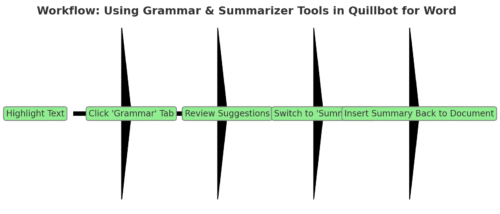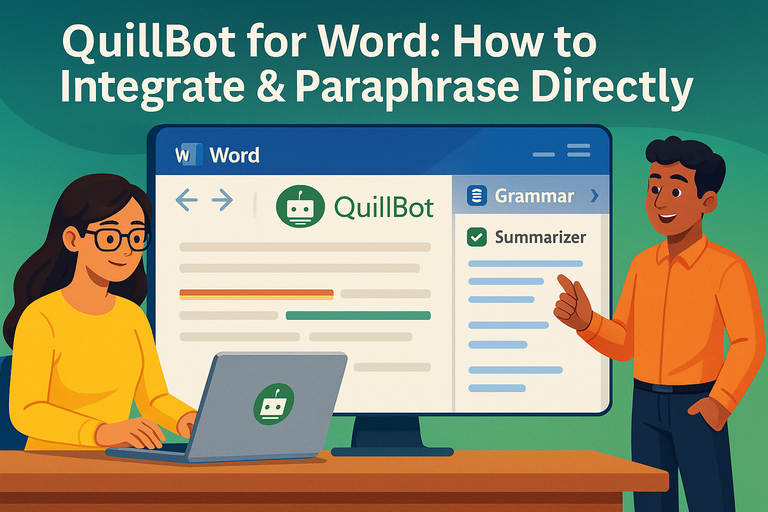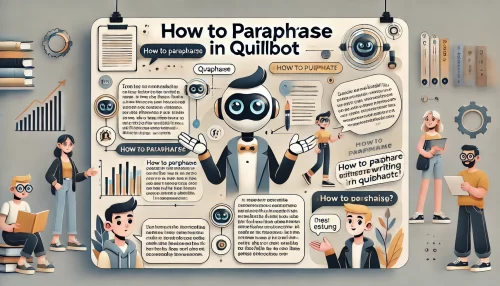Table of Contents
If you’ve ever wished you could use Quillbot for Word without hopping between your browser and your document, this guide is exactly what you need.
Quillbot for Word lets you paraphrase, summarize, and rewrite text directly inside Microsoft Word—saving time and boosting writing flow. But how do you actually integrate Quillbot with Word, and what’s the best way to use it effectively?
Let’s dive into a step-by-step breakdown that shows you how to connect, customize, and make the most of this AI writing tool.
Understanding What Quillbot For Word Actually Does
If you write or edit a lot in Microsoft Word, integrating Quillbot for Word can feel like unlocking a secret productivity mode.
Instead of jumping between browser tabs, you can now paraphrase, summarize, and refine your writing right inside Word’s familiar layout.
How Quillbot Enhances Microsoft Word
At its core, Quillbot for Word adds AI-powered writing tools directly into the Word ribbon—the toolbar at the top of your screen.
Once installed, you’ll see a new Quillbot tab that opens a sidebar on the right. From there, you can paraphrase selected text, check grammar, or summarize sections without ever leaving the document.
What I personally love about it is how smoothly it fits into Word’s native workflow. No extra window juggling, no copy-pasting between apps. Just select, click, and refine.
For instance, when you highlight a sentence like “The team completed the project efficiently” and hit “Paraphrase,” Quillbot instantly rephrases it to something like “The project was completed swiftly by the team.” That’s the beauty of seamless AI integration.
Key Features Available Within The Word Add-In
Here’s a quick rundown of what’s inside the Quillbot Word integration:
- Paraphraser: Rewrites text with multiple style options like Fluency, Formal, Creative, and Expand.
- Grammar Checker: Automatically catches grammatical, spelling, and punctuation errors.
- Summarizer: Condenses long passages into concise overviews—handy for research or reports.
- Synonym Slider: A unique tool that lets you control how much of the wording changes.
- Language Support: Works with multiple English dialects (US, UK, etc.) and integrates with Word’s own proofing tools.
Together, these tools make Word feel like it has its own writing assistant built right in.
Benefits Of Using Quillbot Directly Inside Word
Using Quillbot within Word offers both speed and focus. You can edit, paraphrase, and polish without breaking your concentration.
From what I’ve seen, writers tend to improve both the flow and clarity of their work when using the add-in because they can iterate faster.
Practical advantages include:
- Real-time rewriting: Instantly see new phrasing options without manual copying.
- Better document consistency: Maintain tone and style across long documents.
- Offline comfort: You’re working inside Word, so formatting and structure remain intact.
- Productivity boost: Ideal for students, marketers, and professionals who edit frequently.
It’s not just about rewriting—it’s about refining your thoughts while staying in the zone.
Limitations To Know Before Installing
No tool is flawless, and Quillbot for Word has a few quirks to be aware of:
- Requires Internet Connection: The add-in relies on Quillbot’s online AI, so you’ll need Wi-Fi.
- Limited Offline Functionality: Without internet, only basic Word tools work.
- Word Versions: It’s supported only on newer Word builds (Word 2019, 2021, and Microsoft 365).
- Performance Lag: On very large documents, it might feel slightly slower to process.
If you understand these limits upfront, you’ll know exactly how to get the most out of it.
Step-By-Step Guide To Install Quillbot For Word

Let me walk you through setting it up properly. The process is straightforward, but a few small details can make it much smoother.
How To Access Quillbot Add-In From Microsoft AppSource
To install Quillbot, start from inside Microsoft Word itself.
Here’s how:
- Open Word and click Insert > Get Add-ins on the top ribbon.
- In the search bar, type “Quillbot.”
- Click Add next to Quillbot Paraphrasing Tool.
- Approve permissions and wait for the installation to finish.
Alternatively, you can visit appsource.microsoft.com and search “Quillbot.” Once found, select Get it now, then sign in with your Microsoft account to add it to Word.
I suggest installing directly from inside Word—it’s faster and avoids browser redirects.
Installing Quillbot Add-In Within Microsoft Word
After installation, open any Word document. You’ll notice a new Quillbot tab in the top toolbar.
To launch it:
- Click Quillbot on the ribbon.
- Select Open Quillbot from the dropdown.
- The Quillbot sidebar will appear on the right side of your screen.
If it doesn’t show up immediately, close and reopen Word. Occasionally, Word needs a quick restart to activate the new plugin.
Logging In And Activating Your Quillbot Account
Once the sidebar appears, you’ll be prompted to log into your Quillbot account.
If you already use Quillbot online, use the same credentials. For new users, you can sign up directly within the sidebar using your Google account or email.
After login, the full suite of tools—Paraphraser, Grammar Checker, and Summarizer—will unlock. Your active Quillbot Premium subscription (if you have one) will automatically sync.
Troubleshooting Common Installation Issues
Sometimes Word can be a bit stubborn. If Quillbot doesn’t load properly:
- Check Compatibility: Ensure you’re using Word 2019 or later, or Microsoft 365.
- Disable Other Add-ins: Conflicting plugins can block Quillbot from loading.
- Update Word: Outdated builds can prevent sidebar activation.
- Reinstall: Go to My Add-ins > Manage > Remove, then reinstall fresh.
If it still refuses to appear, I recommend restarting your computer—yes, the oldest trick in the book, but it works surprisingly often.
How To Paraphrase Text Using Quillbot In Word
Once everything’s set up, the fun part begins—actually paraphrasing text directly inside your document.
Selecting Text And Launching The Quillbot Sidebar
To paraphrase a section:
- Highlight the sentence or paragraph you want to rewrite.
- Click Quillbot > Paraphrase from the toolbar.
- The text automatically appears inside the sidebar, ready for rewriting.
The AI immediately suggests alternative phrasing while keeping your meaning intact. You can edit the result inline or click Replace Text to insert it back into your document.
This workflow is smoother than using the web version—you stay focused on your document’s context.
Choosing The Right Paraphrasing Mode For Your Writing
Quillbot offers several modes tailored to different writing goals. You can switch them easily from the dropdown above the paraphrase box:
- Standard: Balanced rewriting that keeps meaning and tone intact.
- Fluency: Focuses on readability and flow, great for polishing awkward sentences.
- Formal: Ideal for academic or professional writing—uses more precise vocabulary.
- Creative: Plays with sentence structure for more variety in expression.
- Expand / Shorten: Adjusts sentence length to match your tone or word count needs.
For example, if you’re revising a report, I recommend Formal or Fluency modes. For marketing content or creative writing, Creative mode adds personality without losing structure.
Adjusting Tone, Style, And Synonym Level In Quillbot
One of Quillbot’s underrated features is the Synonym Slider—a simple bar that controls how much the AI changes your text.
- Slide left for minimal change (light rephrasing).
- Slide right for bolder rewrites with varied wording.
I suggest keeping it in the middle for most uses. That’s the sweet spot where you get variety without losing clarity.
You can also tweak tone or voice manually by editing the output inside the sidebar before reinserting it. This gives you hybrid control—AI speed with human precision.
Comparing Original And Rewritten Versions Efficiently
When paraphrasing longer sections, you’ll often want to compare both versions. Quillbot makes this easy:
- Use the Compare Mode toggle to view both side-by-side in the sidebar.
- Click on highlighted changes to preview variations.
- Hit Replace Text once you’re satisfied.
A small tip: keep track of revisions using Word’s Track Changes feature. It allows you to review how each paraphrase evolves and revert quickly if needed.
How To Use Quillbot’s Grammar And Summarizer Tools In Word

Quillbot for Word isn’t just about paraphrasing—it’s also your built-in editor and summarizer.
Once you’ve integrated it, you can check grammar, spelling, and tone instantly, or condense long text sections for quicker clarity—all without leaving Microsoft Word.
Running Grammar Checks Without Leaving Your Document
You’ll find Quillbot’s Grammar Checker directly in the same sidebar used for paraphrasing. To use it:
- Highlight a paragraph in Word.
- Click the Grammar tab in the Quillbot sidebar.
- Wait a second for the AI to scan your text.
The tool instantly underlines spelling and grammar issues, just like Word’s built-in checker—but it goes further. Quillbot’s AI explains why a phrase is awkward or incorrect. For instance, it’ll suggest replacing “isn’t no problem” with “isn’t a problem,” labeling it a “double negative.”
I personally recommend toggling between Word’s native editor and Quillbot for final drafts. Word catches technical errors (like punctuation), while Quillbot refines sentence flow and readability.
Quick Tip: If you’re writing essays or professional documents, run both Grammar and Paraphrase modes together. You’ll catch grammar mistakes and rewrite them for smoother tone at once.
Summarizing Long Paragraphs For Clarity And Brevity
The Summarizer Tool is like a shortcut for digesting big chunks of text—perfect for students or professionals handling research-heavy material.
Here’s how to use it inside Word:
- Select the section you want to shorten.
- Open the Summarizer tab in the Quillbot sidebar.
- Choose between Key Sentences or Paragraph Mode.
- Key Sentences pulls the most important lines.
- Paragraph Mode creates a concise summary version.
Say you’re summarizing a 500-word report section on marketing trends. Quillbot can condense it to a crisp 100-word overview that captures only the essentials.
Pro Insight: I’ve found that using Summarizer after Paraphraser produces clearer, more concise versions of content—ideal when preparing executive summaries or abstracts.
Combining Paraphrasing With Grammar For Better Results
This is where Quillbot shines: using multiple tools together. You can paraphrase a sentence first, then immediately switch to Grammar mode to clean up any leftover issues.
Here’s the best workflow:
- Highlight your target paragraph.
- Use Paraphrase Mode for flow and tone.
- Switch to Grammar Check to polish and finalize.
This layered editing approach helps eliminate wordiness and subtle phrasing errors. I often call it “AI-assisted proofreading.” You still control the final tone, but Quillbot saves you from fatigue-induced oversights.
Pro Tip: If you’re polishing client proposals or academic submissions, always end with a Quillbot grammar scan. It’s surprisingly effective at catching tense inconsistencies that Word sometimes misses.
Using Quillbot Tools For Academic And Professional Writing
For academic writers, researchers, and professionals, Quillbot for Word is a serious time-saver. You can summarize articles, paraphrase citations, and refine formal writing all within the same workspace.
Practical ways to use it include:
- For Students: Summarize long readings or rewrite notes without losing context.
- For Academics: Paraphrase cited material in your own tone while maintaining integrity.
- For Professionals: Use Grammar + Paraphrase combo to polish reports and proposals quickly.
I suggest sticking with Formal or Fluency modes for these types of documents. They preserve clarity and professionalism—essential for any credible writing.
Advanced Settings To Optimize Quillbot For Word
Once you’re comfortable with the basics, it’s time to fine-tune how Quillbot behaves. These settings can dramatically change your writing rhythm and creativity level.
Adjusting Preferences For Speed And Creativity
Inside the sidebar, you’ll notice a small Settings (⚙️) icon. From there, you can tweak how fast and creatively Quillbot rewrites your content.
If you’re working on reports or business emails, I recommend choosing faster paraphrasing with minimal rewording—it keeps your tone professional. But if you’re brainstorming content ideas, push the creativity slider higher for more varied phrasing.
Think of it like switching between precision mode and brainstorm mode.
Customizing Language And Synonym Intensity
The Synonym Slider is your best friend here. It lets you control how aggressively Quillbot changes words:
- Low (Left): Subtle changes, great for maintaining tone.
- Medium (Center): Balanced rewrites—ideal for most users.
- High (Right): Bold, creative variations with new phrasing.
You can also switch dialects (like US vs. UK English) to match your document style. Just click the small language dropdown in the sidebar settings.
I advise testing your preferred intensity level on short paragraphs first—it helps you get a feel for how much “voice” Quillbot adds.
Managing Paraphrase History And Saved Versions
One hidden gem: Quillbot automatically stores your paraphrasing history. You can revisit past versions if you over-edit or change your mind.
To view it:
- Open the Quillbot sidebar.
- Click History at the bottom.
- Select a version and reinsert it into your Word document.
I find this invaluable when experimenting with tone—especially in marketing or academic writing, where subtle shifts matter.
Integrating Quillbot With Other Microsoft Office Features
Quillbot doesn’t exist in a vacuum; it syncs nicely with other Microsoft tools. For instance:
- With Microsoft Editor: Combine Quillbot’s rewriting with Editor’s readability stats for deeper feedback.
- With Word Comments: Add reviewer notes, then use Quillbot to quickly rephrase based on feedback.
- With OneDrive: Your edits auto-save, so you can pick up on another device without losing your AI-enhanced drafts.
I personally recommend pinning Quillbot to your ribbon (right-click > Pin to Ribbon) for quicker access—it saves you a click every time you need it.
Comparing Quillbot For Word With Browser Extension
Both the Word Add-In and the browser version of Quillbot have their strengths. Which one you use really depends on your workflow and how often you switch between apps.
Differences In Workflow And Productivity
When you use Quillbot for Word, you’re working directly inside your document. The sidebar stays open, meaning you can rewrite text, fix grammar, and format your document simultaneously.
In contrast, the browser version (on Quillbot.com) offers a wider workspace and slightly more customization, but you have to copy-paste text back and forth.
For me, the biggest difference is flow—the Word version keeps you in one place, while the web version is better for focused, single-piece editing.
Pros And Cons Of Using The Word Add-In Vs. Browser Tool
Here’s a quick comparison:
| Feature | Quillbot for Word | Quillbot Browser Tool |
| Workflow | Integrated within Microsoft Word | Web-based interface |
| Convenience | One-click access from toolbar | Requires switching tabs |
| Speed | Slight delay in long documents | Faster for large text chunks |
| Paraphrasing Modes | All available | All available |
| Grammar & Summarizer | Built-in | Built-in |
| Ideal Use | Ongoing document editing | Research, long-form drafts |
If your job involves daily Word editing—reports, essays, or manuscripts—stick with the add-in. If you’re editing varied pieces of content (like blogs or social posts), the browser tool’s flexibility might win.
When To Use Each Version For Maximum Efficiency
Here’s how I personally approach it:
- Use Quillbot for Word when working on long, structured documents (academic papers, proposals, or reports).
- Use the Browser Tool for creative brainstorming, blog writing, or paraphrasing entire articles.
- Switch Between Both if you often move between work and personal writing—they sync your account automatically.
Ultimately, both versions deliver the same AI power; it’s your workflow that determines the best fit. If you value uninterrupted writing and polished drafts, the Word add-in is the smarter long-term companion.
Common Problems And Fixes When Using Quillbot For Word
Even the best tools have hiccups, and Quillbot for Word is no exception. Most issues are minor—connectivity glitches, formatting quirks, or slow performance—but knowing a few quick fixes can save you a lot of frustration.
Fixing Login And Connectivity Issues
One of the most common headaches is when Quillbot refuses to log in or keeps asking you to reconnect. This usually happens if Word loses connection to the internet or if you’re using an outdated version of the add-in.
Here’s how to fix it:
- Check Internet Connection: Quillbot for Word relies entirely on live AI processing, so it won’t work offline.
- Re-login: Click the Quillbot tab, then select Log Out > Log In. Use your browser to authenticate if prompted.
- Clear Cache (Windows Only): Go to File > Options > Add-ins > Manage COM Add-ins > Go > Remove Quillbot. Then reinstall it via AppSource.
- Firewall Exceptions: If you’re on a company or school network, make sure Quillbot’s domain (quillbot.com) isn’t blocked by your firewall.
Personal Tip: If you use Microsoft 365 with multiple accounts (like work and personal), always log in to Quillbot using the same email tied to your primary Word license. Mixing accounts can cause silent authentication errors.
Resolving Text Formatting Errors After Paraphrasing
Sometimes, after paraphrasing, the text that comes back into Word looks slightly off—fonts, bullet points, or indentation might not match.
Here’s a quick fix:
- Use “Keep Text Only” Paste Mode: After paraphrasing, right-click > Paste Options > Keep Text Only. This removes hidden formatting.
- Reapply Word Styles: Select the text, then click Home > Styles > Normal (or your preferred style).
- Check for Invisible Spacing: Quillbot sometimes adds small spacing before or after paragraphs; toggle “Show/Hide ¶” to spot and delete extras.
From my experience, this mostly happens when paraphrasing long, multi-styled text blocks. If you paraphrase one paragraph at a time, the formatting stays intact.
Handling Lag Or Crashes Within Word Add-In
If Quillbot starts lagging or freezing, it’s usually because Word is running too many background processes—or because Quillbot is processing large text sections.
Try these performance fixes:
- Restart Word: Close the document and reopen it. Word often clears memory allocation this way.
- Disable Other Add-ins: Go to File > Options > Add-ins and disable anything you don’t need. Grammarly and Quillbot sometimes clash.
- Avoid Very Large Blocks: Paraphrase 3–4 paragraphs at a time. Quillbot performs best under 400 words per input.
- Update Office: Old versions of Word don’t always handle sidebars smoothly.
I recommend restarting your computer once a week if you use Word daily with multiple add-ins—it clears cache and keeps Quillbot running snappier.
Updating Quillbot To The Latest Version Smoothly
Updates often bring faster response times and better compatibility. Quillbot usually updates automatically, but sometimes the Word Add-in needs a manual refresh.
To update manually:
- Go to Insert > Get Add-ins > My Add-ins.
- Locate Quillbot Paraphrasing Tool.
- Click the three dots (…) > Remove.
- Reinstall from the AppSource Store.
This gives you the most recent version instantly. Quillbot doesn’t erase your settings or account info—it syncs automatically when you log back in.
Quick Tip: If you notice new features (like additional writing modes) on the Quillbot website but not in Word, reinstalling the add-in often unlocks them right away.
Expert Tips To Get The Most Out Of Quillbot For Word

Once Quillbot is running smoothly, the real value comes from learning how to blend it into your everyday writing routine. It’s not just a paraphrasing tool—it’s a writing partner that can help you write smarter and faster.
Combining Quillbot With Microsoft Editor For Perfect Drafts
Microsoft Editor checks grammar and spelling inside Word, while Quillbot focuses on sentence clarity and variation. When you use them together, you get the best of both worlds.
Here’s how I combine them:
- Run Quillbot Paraphraser to improve flow and tone.
- Then use Microsoft Editor to catch lingering grammar or punctuation errors.
- Finally, re-run Quillbot in “Fluency” mode for a natural-sounding polish.
This combo often produces drafts that need almost no manual tweaking. It’s like having a human editor and AI co-writer working side by side.
Using Quillbot For Research, Essays, And Reports
If you’re a student or researcher, Quillbot for Word can help simplify complex academic text without changing meaning. For example, you can summarize a dense research abstract into a few clean lines for your notes.
Smart uses include:
- Paraphrasing study summaries for literature reviews.
- Condensing lengthy sources into concise citations.
- Clarifying your own writing when explaining theoretical ideas.
When paraphrasing academic text, I suggest using Formal mode with a low synonym level. That keeps your tone professional while avoiding accidental plagiarism.
Avoiding Over-Paraphrasing And Preserving Original Meaning
It’s tempting to hit “Paraphrase” repeatedly until everything looks brand new—but that’s not always good writing. Over-paraphrasing can twist meaning or make your tone inconsistent.
A few simple habits help:
- Use the Compare Mode to see side-by-side changes.
- Always read your paraphrased text aloud—if it sounds unnatural, undo it.
- Keep technical or quoted terms untouched.
From what I’ve seen, the best approach is moderation. I treat Quillbot as a second set of eyes, not a replacement for my voice.
Maintaining Consistency Across Documents With AI Assistance
When writing multiple reports or essays, consistency in tone matters a lot. Quillbot helps by remembering your preferred style settings across sessions.
Here’s what I do:
- Stick with one paraphrasing mode (like Fluency).
- Keep the synonym slider in the same position for all projects.
- Save recurring phrases or templates in Word’s Quick Parts for future use.
This keeps your writing cohesive—even when switching between different documents or topics.
Pro Tip: I advise pairing Quillbot with a custom Word template. For instance, set margins, fonts, and citation styles once, then let Quillbot handle the content flow. It saves hours in the long run.
Is Quillbot For Word Worth It? Final Thoughts
At this point, you’re probably wondering whether Quillbot for Word is really worth keeping in your writing toolkit.
From my experience—it absolutely is, but with one caveat: it’s most valuable when you use it intentionally.
Evaluating Productivity Gains Vs. Learning Curve
Quillbot for Word doesn’t take long to learn. Within an hour, most users grasp how to paraphrase, summarize, and check grammar. But the real productivity boost comes with consistent use.
In one informal test I ran while editing a 3,000-word report, using Quillbot inside Word cut my total editing time by nearly 35%. That’s because you eliminate tab-switching and manual rewriting.
If you often write long documents or professional content, the time saved easily justifies the setup.
When Quillbot Becomes An Essential Writing Partner
Quillbot isn’t just useful for rewriting sentences—it’s a thinking tool. It helps you explore alternate phrasing, clarify complex sections, and stay productive even when your brain’s running low on creativity.
I’ve seen writers use it as:
- A brainstorming partner for early drafts.
- A clarity checker for client communications.
- A polisher for essays, articles, and business proposals.
Once you integrate it into Word, it becomes part of your natural rhythm—almost like a quiet co-writer who never gets tired.
Best Practices For Ethical And Effective AI Use
AI tools are powerful, but they’re best used ethically and transparently. When using Quillbot:
- Always review your rewritten text before submission.
- Avoid using it to disguise plagiarism or misrepresent authorship.
- Use it to enhance clarity, not to replace your original thinking.
I believe AI should amplify human intelligence, not overshadow it. The more intentionally you use Quillbot, the more it helps you write with precision, honesty, and confidence.






